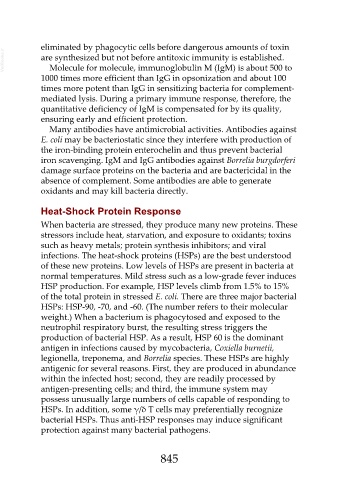Page 845 - Veterinary Immunology, 10th Edition
P. 845
eliminated by phagocytic cells before dangerous amounts of toxin
VetBooks.ir are synthesized but not before antitoxic immunity is established.
Molecule for molecule, immunoglobulin M (IgM) is about 500 to
1000 times more efficient than IgG in opsonization and about 100
times more potent than IgG in sensitizing bacteria for complement-
mediated lysis. During a primary immune response, therefore, the
quantitative deficiency of IgM is compensated for by its quality,
ensuring early and efficient protection.
Many antibodies have antimicrobial activities. Antibodies against
E. coli may be bacteriostatic since they interfere with production of
the iron-binding protein enterochelin and thus prevent bacterial
iron scavenging. IgM and IgG antibodies against Borrelia burgdorferi
damage surface proteins on the bacteria and are bactericidal in the
absence of complement. Some antibodies are able to generate
oxidants and may kill bacteria directly.
Heat-Shock Protein Response
When bacteria are stressed, they produce many new proteins. These
stressors include heat, starvation, and exposure to oxidants; toxins
such as heavy metals; protein synthesis inhibitors; and viral
infections. The heat-shock proteins (HSPs) are the best understood
of these new proteins. Low levels of HSPs are present in bacteria at
normal temperatures. Mild stress such as a low-grade fever induces
HSP production. For example, HSP levels climb from 1.5% to 15%
of the total protein in stressed E. coli. There are three major bacterial
HSPs: HSP-90, -70, and -60. (The number refers to their molecular
weight.) When a bacterium is phagocytosed and exposed to the
neutrophil respiratory burst, the resulting stress triggers the
production of bacterial HSP. As a result, HSP 60 is the dominant
antigen in infections caused by mycobacteria, Coxiella burnetii,
legionella, treponema, and Borrelia species. These HSPs are highly
antigenic for several reasons. First, they are produced in abundance
within the infected host; second, they are readily processed by
antigen-presenting cells; and third, the immune system may
possess unusually large numbers of cells capable of responding to
HSPs. In addition, some γ/δ T cells may preferentially recognize
bacterial HSPs. Thus anti-HSP responses may induce significant
protection against many bacterial pathogens.
845

